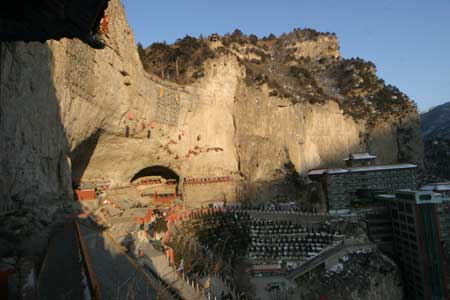Recommended recreation routes in Mianshan Mountain
Mianshan Mountain is the birthplace of national intangible cultural heritage—the Chinese Qingming/Hanshi Festival. It is located in Jiexiu City of central Shanxi Province, 137 kilometers south of Taiyuan and 125 kilometers north of Linfen.
Mianshan Mountain has 14 resort areas including about 400 places for sightseeing. Here are five routes recommended for a day journey.
1. The route of Tang Dynasty culture

This route has 69 places for sightseeing and the resort areas, Dragon Ridge Peak, Dragon Head Temple and Nun Lee Cliff Scenic Zone. Here tourists can touch the culture of the Tang Dynasty and see how the Golden Years of Zhenguan (627-649), an era marked by peace, prosperity, openness and efficient government, emerged.
As large as a royal palace, the temple in Nun Lee Cliff displays sculptures of the Tang Dynasty. The large sculpture of Jie Zitui and his mother is the most popular tourist attraction in Dragon Ridge Peak. Wen Yanbo, a prime minister of the Northern Song, ordered the construction of Jingjie Pavilion and the sculpture of Jie Zitui and his mother to praise their noble characters and sterling integrity. Nearly 10 meters tall, the sculpture of Jie Zitui and his mother is ancient, classical and vivid. It is the symbol of Mianshan Mountain.
In addition to art, the tour features spurting springs, hanging waterfalls, natural forests and grasslands and green pine and cypress trees. According to legend, the atmosphere of Mianshan Mountain attracted a great number of celestial beings and sacred persons. The mountain has more than 10 caves near where Peng Ancestor, Hua Tuo, Han Zhongli and Lu Dongbin once cultivated themselves. Peng Ancestor is the God of Longevity. Before he became immortal, Peng Ancestor toured Mianshan Mountain, sat in meditation under a cliff and obtained the skills of recovering his youthful vigor.
Later local people came here to pray for longevity. The legend states several hundred people became immortal after meditating here and adopting the right practices. Eighteen Chinese emperors lived more than 80 years after preserving their health at Mianshan Mountain.
2. The Taoist cultural route

This route has 84 sightseeing spots and covers Daluo Palace, Sky Bridge, Yidou Spring and Zhujia'ao Hollow. On this route, tourists see complex Taoist architecture. Daluo Palace is known as "Shanxi's Potala Palace" and "The First Taoist Temple Under Heaven."
3. The Buddhist cultural route

The route has 66 sightseeing locations and covers the scenic areas of Yunfeng Temple and Zhengguo Temple. The main tourist attractions are Lingyin Terrace of the King of Immateriality, Five-dragon Pine, Shangfang Academy, Zhengguo Temple Kaiyuan Tablet and Tongtianyunqu, a name which means cloud thoroughfare to heaven.
The King of Immateriality is the Buddha of the Yunfeng Temple and Mianshan Mountain. Born in the Tang Dynasty, his common name is Tian Zhichao. At the center of the main hall of the Yunfeng Temple is the statue mold of the clay-covered body of Tian Zhichao. The Zhengguo Temple has three halls which hold 12 molds of the bodies of eminent monks of the Tang, Song and Yuan dynasties. Though a thousand years have elapsed, their skeletons are well preserved. They are important cultural relics for the study of the history and culture of Mianshan Mountain.
4. Cold Food Festival cultural route

The Cold Food Festival of Mianshan Mountain integrates social civilization, traditional morals, literature and arts and the cuisine of China.
The Chinese celebrated the Cold Food Festival for more than 2,600 years, and because of that, China has accumulated a profound cold food culture. The Tang Dynasty has produced nearly 300 poems about the Cold Food Festival. The dynasty also created many stories, novels and legends about the festival.
Emperor Xuan Zong (685-762) of the Tang Dynasty issued an edict that designated the Cold Food Festival as a national holiday. The Cold Food Festival is believed to be significant to the construction of a harmonious society and an important component in maintaining family unity.
5. The natural landscape route

This route has 101 spots for sightseeing and covers the scenic areas of Shuitao Gully, Guteng Valley and Shengru Spring. Since the times of ancient China, these places have been regarded as sacred places for health. The trip showcases many beautiful caves and a natural forest consisting of grasslands, lush pine trees and cypress trees. The forest creates what has been described as a natural oxygen bar. Modern medical science has proved that cypress trees and leaves can help relieve uneasiness, nourish the brain and soften blood vessels.
 0
0 







Go to Forum >>0 Comments